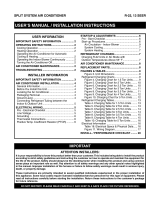
7
modification to the expansion device and refrigerant
charging procedures for proper and efficient system
operation.
• The refrigerant charge can be checked and adjusted
through the service ports provided external to the outdoor
unit. Use only gage line sets which have a “Schrader”
depression device present to actuate the valve.
• A high-pressure switch is factory-installed and located in the
compressor discharge line internal to the outdoor unit. The
switch is designed to de-energize the system when very
high pressures occur during abnormal conditions. Under
normal conditions, the switch is closed. If the discharge
pressure rises above 575 psig, then the switch will open
and de-energize the outdoor unit. The switch will close
again once the liquid pressure decreases to 460 psig.
Please note that the switch interrupts the thermostat inputs
to the unit. When the switch opens and then closes, there
will be a 5 minute short cycling delay before the outdoor
unit will energize.
Charging the Unit in AC mode
If the outdoor temperature is 65 degrees F or higher:
After completing the refrigerant line connections, leak
checking the system, and evacuating the indoor section
and all line connections (using proper methods), perform
the following steps:
1. Determine the recommended charge addition (if applicable)
for the system being installed. This information is in the
unit’s QRD (Quick Reference Data sheet).
2. Calculate the amount of additional refrigerant needed for
the line set length of the actual installation. This information
is on the first page of the unit’s QRD (Quick Reference
Data sheet).
3. Weigh in the additional charge amounts determined by
step 1 and 2 above.
4. Adjust the charge to match the superheat (for fixed orifice
systems) or subcooling (for TXV systems). There are three
different resources for doing this:
a.) The chargecalculator.com website. This will walk
you through the charging process step by step.
b.) The charging tables on the inside of the outdoor
unit’s electrical box cover panel. These tables
provide superheat targets for fixed orifice systems
and subcooling targets for TXV systems. The system
should be charged so that the measured superheat/
subcooling are within 1 degree F of the target listed
in the table.
For fixed orifice systems:
• If your measured superheat at the suction valve is
LESS THAN the recommended superheat value
in the table then REMOVE refrigerant.
• If your measured superheat at the suction valve
is GREATER THAN the recommended superheat
value in the table then ADD refrigerant.
For TXV systems:
• If your measured subcooling at the liquid valve is
LESS THAN the recommended subcooling value
in the table then ADD refrigerant.
• If your measured subcooling at the liquid valve is
GREATER THAN the recommended subcooling
value in the table then REMOVE refrigerant.
c.) The charging tables in the Supplemental Charging
Information, can be found online in the literature
library. The tables can also be accessed by scanning
the QR code on the unit’s electrical panel. The
pressures listed in these tables are for reference
only and are to be used in troubleshooting a system.
The system should be charged to match the
superheat or subcooling targets as previously
noted and not to match the system pressures.
Follow the same procedure described in 4b above.
If the outdoor temperature is below 65 degrees F:
After completing the refrigerant line connections, leak
checking the system, and evacuating the indoor section
and all line connections (using proper methods), perform
the following steps:
1. Determine the recommended charge addition (if applicable)
for the system being installed. This information is in the
unit’s QRD (Quick Reference Data sheet).
2. Calculate the amount of additional refrigerant needed for
the line set length of the actual installation. This information
is on the first page of the unit’s QRD (Quick Reference
Data sheet).
3. Weigh in the additional charge amounts determined by
step 1 and 2 above.
4. Return to the system when the outdoor temperature is 65
degrees F or higher and follow the steps defined in step
4 of the “If the outdoor temperature is 65 degrees F or
higher” section above.
COMPONENT FUNCTIONS
High Pressure Switch (HPS) - A high-pressure switch is
factory-installed and located in the liquid line internal to the
outdoor unit. The switch is designed to protect the system
when very high pressures occur during abnormal conditions.
Under normal conditions, the switch is closed. If the liquid
pressure rises above 575 psig, then the switch will open and
de-energize the outdoor unit. The switch will close again
once the liquid pressure decreases to 460 psig. Please
note that the switch interrupts the thermostat inputs to the
unit. Thus, when the switch opens and then closes, there
may be a 5 minute short cycling delay before the outdoor
unit will energize.
Low-Pressure Switch - (Select Models) A low-pressure
switch is factory-installed and located in the suction line
internal to the outdoor unit. The switch is designed to
protect the compressor from a loss of charge. Under normal
conditions, the switch is closed. If the suction pressure falls
below 5 psig, then the switch will open and de-energize the
outdoor unit. The switch will close again once the suction
pressure increases above 20 psig. Please note that the switch
interrupts the thermostat inputs to the unit. When the switch
opens and then closes, there will be a 5 minute short cycling
delay before the outdoor unit will energize.












